How New Yorkers Became Convinced That Dinosaur Bones Were Buried in Central Park
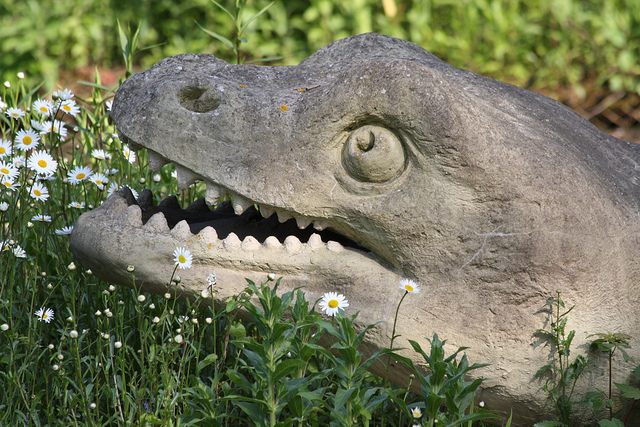
Crystal Palace Park dinosaur, designed by Benjamin Hawkins. (Photo: Gareth Williams/flickr)
Besides the daily contributions of water bottles and cigarette butts, the ground beneath Central Park contains multitudes—layers of ancient schist, deposits from vast glaciers, and caches of long-dead fossilized creatures. But perhaps the most intriguing rumored underground items are the bone-white remains of a museum that never was—the casts and models of dinosaurs and other prehistoric beings constructed by the brilliant sculptor Benjamin Waterhouse Hawkins, supposedly dreaming a shattered sleep somewhere beneath the park as the tourists stroll above.
That’s right: Despite evidence to the contrary, people believe that fake dinosaur bones are buried in Central Park.

The legend is repeated in the delightful children’s book by Barbara Kerley, The Dinosaurs of Waterhouse Hawkins; on Wikipedia; and in some New York Times articles. Understanding it requires going back to the earliest days of paleontology, before anybody really knew what a dinosaur looked like. Hawkins made the first models, creating the blueprint for every natural history museum and dino-park in the world. The story of the Manhattan dinosaur museum that could never quite get built and the models that were then jettisoned still haunts the city.
Dinosaurs, as a concept, are fairly new. Famed paleontologist and zoologist Richard Owen coined the term “dinosauria” (terrible lizard) in 1842. Hawkins worked with Owen on the Great Exhibition of 1851—a world-changing event in which thousands of exhibitors from across the British Empire and the US introduced a huge range of technological and artistic goods to the masses, paving the way for today’s expos and public museums. The Great Exhibition was housed in the Crystal Palace, a greenhouse-like building featuring interchangeable glass and steel components that became a symbol of Victorian engineering.
When the Exhibition ended, the Crystal Palace moved to Sydenham, a suburb of London, in 1854, when it was graced by the world’s first dinosaur models.
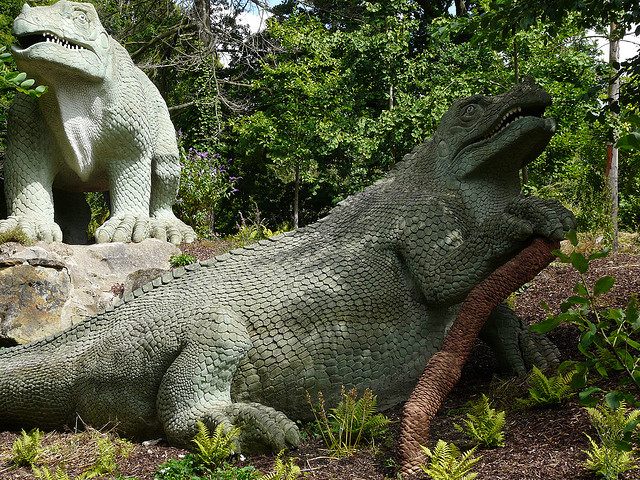
Dinosaurs at Crystal Palace Park. They were classed as Grade II listed buildings from 1973. (Photo: Loz Pycock/flickr)
Some historians say Prince Albert was a fan of Owen’s work, and that it was the prince who wanted the Crystal Palace surrounded by life-sized models of ancient creatures. Owen was made the scientific consultant on the project, and Hawkins—who had once sketched plates of fish and reptiles for Darwin’s Zoology of the Voyage of HMS Beagle—was given the task of constructing life-sized replicas of the prehistoric beasts.
When they were completed, Hawkins’ models of Iguanodon, Megalosaurus, Hylaeosaurus and other ancient reptiles stood atop three specially-made islands encircled by an artificial six-acre lake. The hunched, snarling forms—constructed of stone, wire, clay and cement—were surrounded by lush vegetation and perched atop rocks meant to resemble the fossils in which their blueprints had been found. Though woefully inaccurate by today’s standards, the models became an immediate sensation. The park was swarmed with 40,000 visitors on its opening day of June 10, 1854, and Hawkins’ reputation was made. (The models have survived until today, outlasting the Crystal Palace itself—and are scheduled for renovation, according to just-announced news.)
Hawkins didn’t stay long at the Crystal Palace. His contract ended the following year, perhaps because scientists were already starting to critique the dinosaurs’ re-constructions, or perhaps because the project was too expensive. Hawkins decamped to America (after a brief flirtation with France, in which he unsuccessfully tried to convince Napoleon III to build a fountains in the shape of a mastodon), where he embarked upon a successful tour as a lecturer on natural history. In Philadelphia, he also mounted the first-ever articulated skeleton of a dinosaur, a Hadrosaurus that had been recently discovered in a New Jersey clay pit.
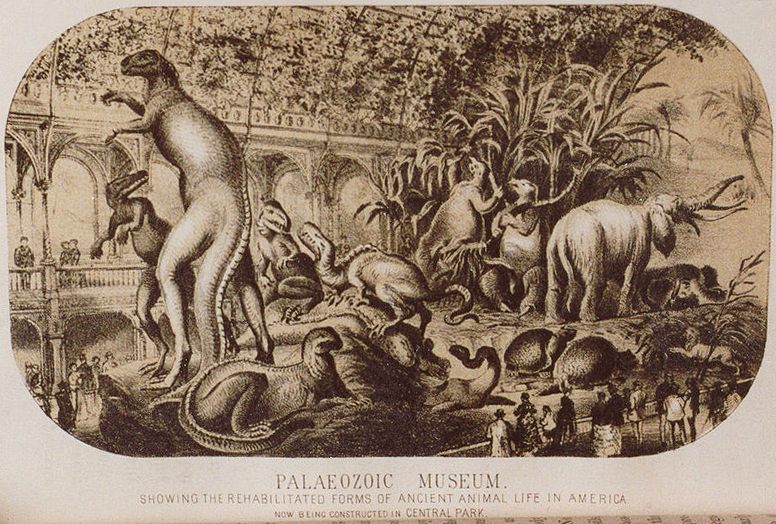
Hawkins’ conceptual drawing of the Paleozoic Museum. (Photo: Wikicommons/Public domain)
In 1868 Hawkins arrived in New York, where he gave several well-attended lectures and told Edward Livingston Youmans, founder of Popular Science magazine, of his intention to “reconstruct the American monsters in Central Park.” Word of Hawkins’ desire reached the man who was then the comptroller of Central Park, Andrew Green, and after brief correspondence, Hawkins was assigned the task of making models for a planned “Paleozoic Museum.”
The details of the museum are somewhat sketchy, but it seems that it was supposed to be modeled in part on the much-admired cast-iron-and-gleaming glass structure of the Crystal Palace. A great arched roof was planned to stretch over models of North American dinosaurs, as well as mastodons, mammoths, and other prehistoric creatures. The museum was to unite “the earliest periods of animal life with the earliest evidence of man’s existence,” in the words of a parks commissioners’ report from 1869, and constitute “a complete visual history of the American continent from dawn of creation to the present time.
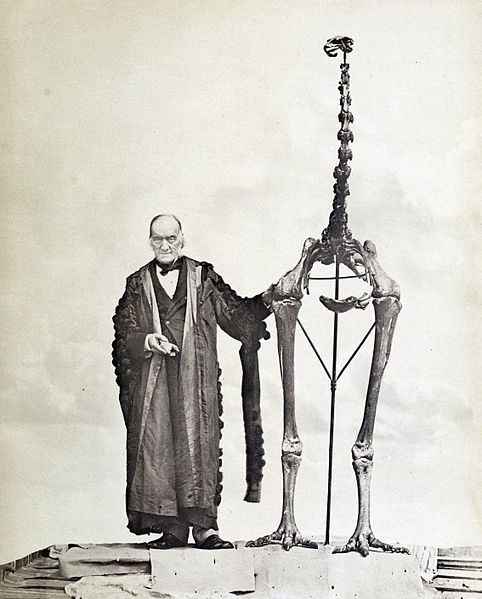
Richard Owen photographed in 1879 next to the largest of all moa, Dinornis maximus (now D. novaezealandiae), while holding the first bone fragment he had examined 40 years earlier. (Photo: WikiCommons/Public domain)
In their paternalistic way, the commissioners hoped the museum would enrich and uplift the masses, whom they felt were in dire need wholesome, scientific entertainment. They also hoped it would tap into a then-booming interest in paleontology, “a branch of natural history of almost romantic interest,” as the commissioners put it in one report.

The dinosaur area at Crystal Palace Park. (Photo: Nick Richards/WikiCommons CC BY-SA 2.0)
“For thousands of years men have dwelt upon the earth without even suspecting that it was a mighty tomb of animated races,” they wrote. “Only in very recent times, which men still remember, was the discovery made that the earth has had a vast antiquity. Huge fishes, enormous birds, monstrous reptiles, and ponderous uncouth mammals had possession of a world, in which man, if there, had not yet established a record of his pre-eminence.”
Hawkins was the one charged with breathing new life into these ancient forms. But almost from the beginning, the project was plagued with setbacks and delays. After starting work in the Arsenal Building, he was moved to a temporary shed, where he worked on creating models of the Hadrosaurus and Laelaps (now called Dryptosaurus), plus other ancient mammals. He had hardly gotten going when he was asked to turn his attention to designing a layout for the new zoological gardens, which interrupted his work. He’d returned to substantive work in January 1870, when in June, an administrative change doomed the project for good.

Benjamin Waterhouse Hawkins. (Photo: WikiCommons/Public Domain)
The administrative shake-up involved Boss Tweed, perhaps the most corrupt politician New York has ever seen. In the summer of 1870—toward the end of Tweed’s reign, but while his grip was still firm—the administration for all parks in New York City was collapsed into one board, helmed by two of Tweed’s henchmen: Peter B. Sweenyand Henry Hilton. Tweed’s men seized upon the Paleozoic Museum as an expensive and ungodly project dreamt up by a foreigner, and vowed to squash it.
By then, Hawkins had become aware of murmurings about the museum’s cost ($30,000 just to build the foundations, according to one account), and wrote to Hilton on Sept 5th 1870, offering modifications to make the project cheaper. On December 22, he received a reply saying his services had been terminated.
Hawkins expressed his severe disappointment with this turn of events a meeting of the Lyceum of Natural History on March 6, 1871—telling the whole story of the museum from the beginning to its sputtering, soul-crushing end.
But if he was hoping for some kind of reinstatement or reconciliation, his words had the opposite effect.
On May 3, vandals armed with sledgehammers and orders from Hilton broke into Hawkins’s workshop and smashed all of his work, including two giant plaster skeletons. The vandals also destroyed all of Hawkin’s molds and sketch models, telling Hawkins, according to an 1875 article in the North American Review, ”he should not bother himself about ‘dead animals,’ when there were so many living ones to care for.” According to the Times, the fragments were buried in an area known as Mt. St. Vincent—once a convent, and now home to Central Park’s composting operation.
The idea that some of the fragments remain persists in some scholarly articles. But Carl Mehling, an enthusiastic Hawkins historian who works in the Paleontology Division of the American Museum of Natural History, thinks it’s unlikely there’s anything left to find. “All I can say is that the truth can’t stop an irresistible rumor … it’s a Bigfoot story,” he says.

The dinosaur models under construction at Benjamin Waterhouse Hawkins’ studio in Sydenham, c. 1853. (Photo: WikiCommons/Public domain)
Mehling points to early articles in the New York Times and other sources saying the fragments were dug up not long after their burial and found to be “worthless.” One 1872 Times article says some of the sculptures were dug up by Hawkins himself, “with what feelings may be imagined.”
Some paleontologists say it’s better that the Paleozoic Museum was never built, since its models would have been almost instantly inaccurate given the rapid rate of paleontology discoveries in that era. The museum also might have competed with the American Museum of Natural History, which began around the same time. Yet there’s something undeniably poignant about the project—it’s an extinct museum commemorating extinct creatures, a stone skipped twice along the surface of the past.
As for Hawkins, he eventually became a recluse at Princeton before returning to England in 1874. But he may yet have left a bit of his work beneath Manhattan’s feet. According to Mehling, there is evidence that the fragments were crushed and used to pave paths in the park.



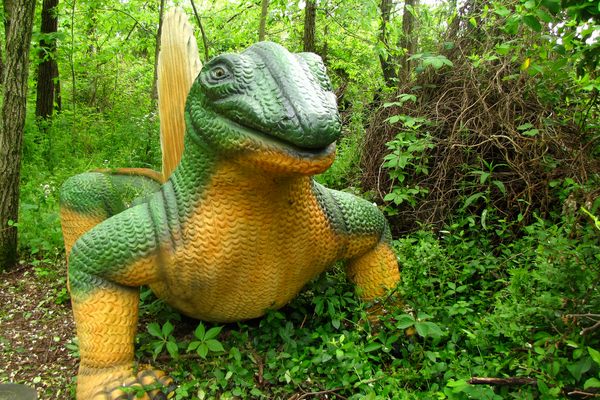

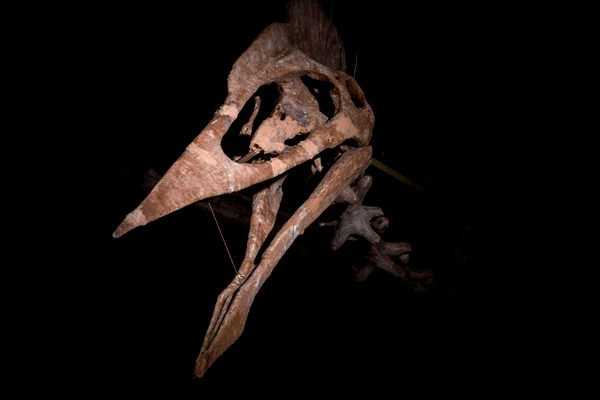










Follow us on Twitter to get the latest on the world's hidden wonders.
Like us on Facebook to get the latest on the world's hidden wonders.
Follow us on Twitter Like us on Facebook